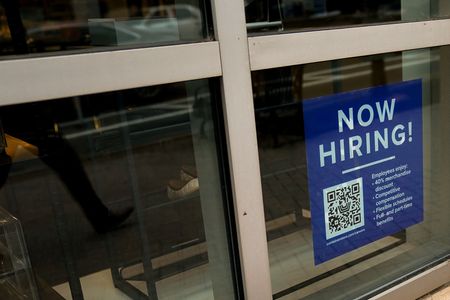By Lucia Mutikani
WASHINGTON (Reuters) – U.S. job openings fell to nearly a three-year low in November as the labor market gradually cools, which could pave the way for the Federal Reserve to start cutting interest rates this year.
Americans are also feeling the shift in the labor market, with the report from the Labor Department on Wednesday showing the number of people quitting their jobs, most likely for higher paying positions, dropping to the lowest level since February 2021. With fewer people job-hopping, wage growth could continue to moderate and ultimately contribute to lower inflation.
But labor market conditions remain fairly strong. There were 1.4 job openings for every unemployed person compared to 1.36 in October. Layoffs were at the lowest level since December 2022. Financial markets are betting the U.S. central bank will begin cutting rates as early as March.
“The Fed is likely in a sweet spot as they prepare markets for an upcoming cut in rates,” said Jeffrey Roach, chief economist at LPL Financial in Charlotte, North Carolina.
Job openings, a measure of labor demand, were down 62,000 to 8.790 million by the last day of November, the Labor Department’s Bureau of Labor Statistics said in its monthly Job Openings and Labor Turnover Survey, or JOLTS report. That was the lowest level since March 2021.
Data for October was revised slightly up to show 8.852 million unfilled positions instead of the previously reported 8.733 million. Economists polled by Reuters had forecast 8.850 million job openings. Vacancies have declined from a record high of 12.0 million in March 2022 following 525 basis points worth of rate hikes from the Fed.
There were 128,000 fewer open positions in the transportation, warehousing and utilities industry. Unfilled jobs fell by 58,000 in the federal government. But vacancies increased by 63,000 in the wholesale trade sector. The job vacancies rate was unchanged at 5.3%.
Medium-sized and large companies accounted for the total decline in open jobs in the private sector. Vacancies, however, remained elevated at small businesses. The U.S. South, which had experienced a surge in employment opportunities, saw a sharp drop in openings, while jobs were abundant in the Midwest.
Hiring continued to lag, falling 363,000 to 5.465 million, the lowest level since April 2020. The professional and business services sector reported a decline of 163,000. The hires rate dropped to 3.5%, also the lowest in nearly four years, from 3.7% in October.
Resignations decreased 157,000 to 3.471 million, the lowest level since February 2021. The drop was led by the professional and business services sector, where quits decreased 77,000.
The quits rate, viewed as a measure of labor market confidence, fell to 2.2%. That was the lowest level since September 2020. The decline in the quits rate, which had held at 2.3% for four straight months, bodes well for slower wage growth and price pressures in the economy.
But with companies hoarding workers following difficulties finding labor in the aftermath of the COVID-19 pandemic, the job market should continue to underpin the economy and probably avert a recession this year.
Layoffs and discharges fell 116,000 to 1.527 million in November, the lowest level in 11 months. The layoffs rate was unchanged at 1.0% for a third straight month.
“Anyone still looking for signs of a recession won’t find it in this report,” said Layla O’Kane, a senior economist at Lightcast. “The Fed has succeeded in managing to curb inflation without blowing up the labor market. I’m expecting that to continue in 2024.”
Stocks on Wall Street were trading lower as investors booked profits after a rally towards the end of last year that was inspired by rate-cut hopes. The dollar gained versus a basket of currencies. U.S. Treasury prices rose.
FOCUS ON PAYROLLS
The Fed last month held its policy rate steady in the current 5.25-5.50% range and policymakers signaled in new economic projections that the historic monetary policy tightening engineered over the last two years is at an end and lower borrowing costs are coming in 2024.
Minutes of that meeting released on Wednesday showed policymakers appeared increasingly convinced that inflation was coming under control, with diminished “upside risks” and growing concern about the damage that “overly restrictive” monetary policy might do to the economy.
Attention now shifts to the release on Friday of the Labor Department’s December employment report, which is expected to show that nonfarm payrolls increased by 170,000 jobs in December, according to a Reuters survey of economists, after a rise of 199,000 in November.
The anticipated December job gain would be below the average monthly rise of 240,000 over the prior 12 months, but well above the roughly 100,000 needed per month to keep up with growth in the working-age population. The unemployment rate is forecast to edge up to 3.8% from 3.7% in November.
News on manufacturing, which has been bruised by the higher borrowing costs, remains downbeat. The Institute for Supply Management (ISM) reported on Wednesday that its manufacturing PMI increased to 47.4 in December after being unchanged at 46.7 for two straight months.
It was the 14th consecutive month that the PMI stayed below 50, which indicates contraction in manufacturing, the longest such stretch since the August 2000-January 2002 period. But the survey likely overstated the weakness in manufacturing and the broader economy, which continues to grow.
“If anything, the survey pushes back against any expectation that the economy significantly slowed at the end of the fourth quarter,” said Will Compernolle, a macro strategist at FHN Financial in New York.
(Reporting by Lucia Mutikani; Editing by Andrea Ricci and Paul Simao)

